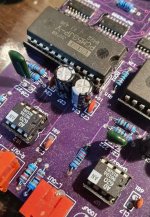The instrument operational amplifier AD623 directly replaces the single operational amplifier op27, and the effect is very good
I observed that the internal circuit of AD623 consists of three operational amplifiers, but in fact, it can directly replace single operational amplifiers such as 5534, 797 and op27
I wonder if there will be any other problems with this application
I observed that the internal circuit of AD623 consists of three operational amplifiers, but in fact, it can directly replace single operational amplifiers such as 5534, 797 and op27
I wonder if there will be any other problems with this application
Are you sure you've got the right part number? The AD623 is an instrumentation amplifier, inappropriate for audio use as
1) far too low a bandwidth and slew-rate
2) Different pin out to standard 8-pin single opamps
3) Very noisy at 35nV/√Hz
4) only supports upto +/-6V supply, not +/-18V as standard.
It most definitely is not pin-for-pin compatible with an OP27 due to the Rg connections and Vref pin.
1) far too low a bandwidth and slew-rate
2) Different pin out to standard 8-pin single opamps
3) Very noisy at 35nV/√Hz
4) only supports upto +/-6V supply, not +/-18V as standard.
It most definitely is not pin-for-pin compatible with an OP27 due to the Rg connections and Vref pin.
Sorry, I did read the wrong model, but the circuit structure of AD620 and 623 are the same. They are instrument amplifiers and the pin function is the same. I used AD620 instead of op27 in this application. It can indeed run,Are you sure you've got the right part number? The AD623 is an instrumentation amplifier, inappropriate for audio use as
1) far too low a bandwidth and slew-rate
2) Different pin out to standard 8-pin single opamps
3) Very noisy at 35nV/√Hz
4) only supports upto +/-6V supply, not +/-18V as standard.
It most definitely is not pin-for-pin compatible with an OP27 due to the Rg connections and Vref pin.
Attachments
Well the AD620 is better than the 623, will cope with +/-15V supplies and has a higher GBW product (although this is still poor).
Its distortion v. frequency is unknown - due to the low bandwidth I'd expect this to be poor at higher frequencies.
The output voltage noise is pretty high, again meaning its better used at higher gain (10x or more rather than as a follower). The noise in that configuration (10x gain or so) is better than the AD623 indeed, but nothing special for an audio opamp. The input current noise is actually extremely good for a bipolar opamp, but that's related to the low input currents and low bandwidth.
The bottom line is instrumentation amps have very different design requirements than audio opamps and are unlikely to be a great fit for an audio application. Instrumentation amps typically are used with strain-guages and thermocouples where BW requirements are modest and gains are normally in the 100 to 10000 range, and good CMRR is crucial.
The good CMRR does point to its use as a differential->single-ended converter, although you don't normally need gain for this, so the high output noise then hits you and makes this probably worse than a '741 !!
Its distortion v. frequency is unknown - due to the low bandwidth I'd expect this to be poor at higher frequencies.
The output voltage noise is pretty high, again meaning its better used at higher gain (10x or more rather than as a follower). The noise in that configuration (10x gain or so) is better than the AD623 indeed, but nothing special for an audio opamp. The input current noise is actually extremely good for a bipolar opamp, but that's related to the low input currents and low bandwidth.
The bottom line is instrumentation amps have very different design requirements than audio opamps and are unlikely to be a great fit for an audio application. Instrumentation amps typically are used with strain-guages and thermocouples where BW requirements are modest and gains are normally in the 100 to 10000 range, and good CMRR is crucial.
The good CMRR does point to its use as a differential->single-ended converter, although you don't normally need gain for this, so the high output noise then hits you and makes this probably worse than a '741 !!
You're right. It's very professionalWell the AD620 is better than the 623, will cope with +/-15V supplies and has a higher GBW product (although this is still poor).
Its distortion v. frequency is unknown - due to the low bandwidth I'd expect this to be poor at higher frequencies.
The output voltage noise is pretty high, again meaning its better used at higher gain (10x or more rather than as a follower). The noise in that configuration (10x gain or so) is better than the AD623 indeed, but nothing special for an audio opamp. The input current noise is actually extremely good for a bipolar opamp, but that's related to the low input currents and low bandwidth.
The bottom line is instrumentation amps have very different design requirements than audio opamps and are unlikely to be a great fit for an audio application. Instrumentation amps typically are used with strain-guages and thermocouples where BW requirements are modest and gains are normally in the 100 to 10000 range, and good CMRR is crucial.
The good CMRR does point to its use as a differential->single-ended converter, although you don't normally need gain for this, so the high output noise then hits you and makes this probably worse than a '741 !!
Thank you for your explanation
